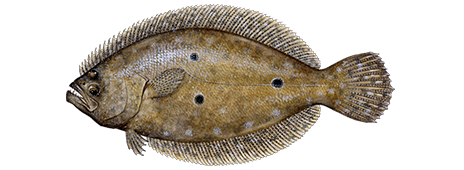Flounder

The flounder is a rapid swimmer and a good light-tackle game fish. It is the most important flatfish of the Atlantic states.
HOW TO IDENTIFY A FLOUNDER
The summer flounder is a left-eyed flatfish. The eye side always blends in perfectly with the sea bed. There is usually a scattering of 10 to 14 eye-like spots on the body. As in other flatfish, the blind side is white and relatively featureless. The teeth are well developed on both sides of the jaws. The dorsal fin has 85-94 rays; the anal fin has 60-63 rays. There are only 5 or 6 gill rakers on the upper limb of the first arch and 11-21 on the lower limb.
WHERE TO CATCH FLOUNDER
Occurs in the western Atlantic from Maine to South Carolina and possibly to northeast Florida. It may be found in water as shallow as 6 in. (15 cm) during the summer, though the largest specimens are found in the depths of 8 to 10 fathoms. In the winter the large fish move offshore into depths of 25 to 80 fathoms. Adults are largely piscivorous and highly predatory, feeding actively in midwater as well as on the bottom. They are often seen chasing bait fish at the surface. It prefers sandy or muddy bottoms and is common in the summer months in bays, harbors, estuaries, canals, creeks, and along shorelines as well as in the vicinity of piers and bridges. The following list includes additional details on where to catch this fish:
BAYS CHANNEL ENTRANCES BAYS AND ESTUARIES MAN-MADE STRUCTURES
HOW TO CATCH FLOUNDER
Drift fishing is the most common fishing method and probably the most effective, since drifting covers more bottom and keeps the bait or lure in motion. Many are also taken by chumming while fishing at anchor, by trolling, or by casting from the shore or pier. Effective baits include strips cut from shark, fluke menhaden, herring, porgy, young bluefish, or sea robin; or piece of blue crab. Effective lures include a small spoon, spinner, or feather. Sometime must be allowed between the moment the flounder picks up the bait and the strike, or the bait will simply be yanked away. Inshore fishing is best on a running tide, and the largest fish are caught late in the season. The following are fishing methods used to catch this fish:
JIGGING BOTTOM BOUNCING SALTWATER JIGGING
DRIFT FISHING STILL FISHING
FLOUNDER LURES, TACKLE & BAIT
The following are lures, tackle or bait that can be used to catch this fish:
CUT BAIT SALTWATER LIVE BAIT SQUID JIGSSHRIMP